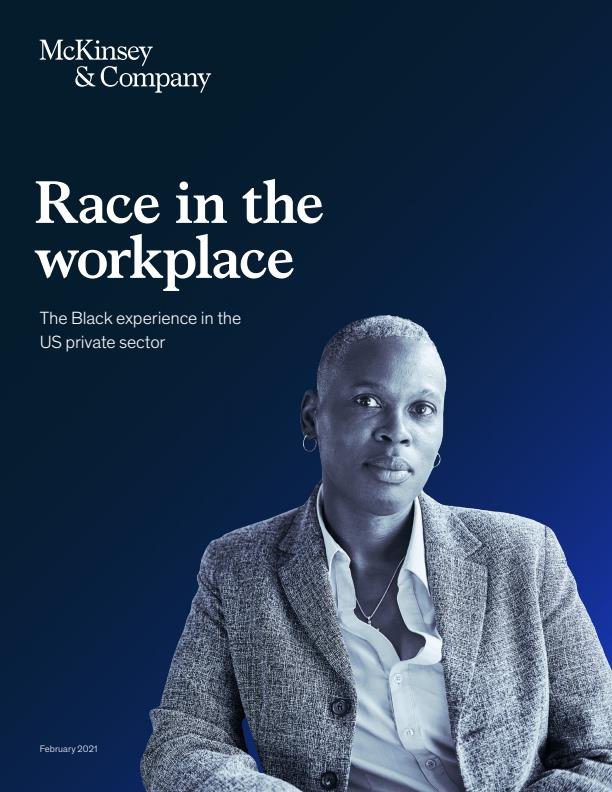This report explores Black workers in the private sector in three parts: first, their participation in the entire US private-sector economy; second, their representation, advancement, and experience in companies; and third, a path forward that includes the key challenges to address, actions companies can take, and additional actions for a wider set of stakeholders to accelerate progress on diversity, equity, and inclusion (DE&I).
The participation of Black workers in the US private-sector economy
In the United States, Black workers account for 15 million, or 12 percent, of the 125 million US private-sector workers.1 The overall Black labor force, including the entire private sector, public sector, and the unemployed looking for work is 20.6 million.2 Our analysis of economic data, primarily drawn from the Bureau of Labor Statistics and the US Census Bureau from 2019,3 as well as the Equal Employment Opportunity Commission from 2018, reinforces the immense complexity of the challenge facing many of the Black private-sector workers today.
The concentration of the Black labor force by geography, industry, and occupation creates challenges and mismatches
Overall, our analysis found that Black workers are underrepresented in the highest-growth geographies and the highest-paying industries. Meanwhile, they are overrepresented in low-growth geographies and in frontline jobs, which tend to pay less.4

The Black labor force is concentrated in states in the South
Almost 60 percent of the Black labor force (11.8 million people) is concentrated in the South, compared with just one-third of the rest of private-sector workers (Exhibit 1).5 As a result, companies located in states with low Black populations—for example, much of the West and parts of the Midwest and Northeast—will need to think differently about how they effectively attract Black talent (Exhibit 2).

The Black labor force is not located in the fastest-growing regions
Overall, Black workers are not located in the places where current job opportunities are and where job growth will likely rise the fastest through 2030. For example, fewer than one in ten Black workers is located in the fastest-growing cities and counties (such as Provo, Utah). Instead, they overwhelmingly live in places where job growth will range from low to above average, with the bright spots being in megacities (such as Chicago) and urban periphery (such as Clayton County, Georgia).6 For the growth to be inclusive in these areas, workers need to be connected to the opportunities being created (for example, transportation between Black neighborhoods and job locations) and have the right skills for in-demand jobs.
Almost half of Black workers are in three industries with a large frontline presence, with significant underrepresentation especially in high-growth, high-wage industries
Our analysis found that 45 percent of Black private-sector workers (approximately 6.7 million people) work in three industries that have a large frontline-service presence: healthcare, retail, and accommodation and food service. These industries also have some of the highest shares of workers making less than $30,000 (Exhibit 3). In retail, 73 percent of Black workers fall into this category; in accommodations and food service, that share is 84 percent.
Conversely, Black workers are underrepresented in industries such as information technology, professional services, and financial services—all sectors that typically have relatively higher wages and job growth.
Fewer than one in ten Black workers is located in the fastest-growing cities and counties.

More Black workers are in jobs with less opportunity for advancement
More Black private-sector workers, 43 percent, make less than $30,000 per year, compared with 29 percent of the rest of private-sector employees (Exhibit 4). In addition, Black workers tend to be in the industries with the largest frontline labor forces. Three in five Black workers work in frontline jobs such as service workers, laborers, operatives, and office and clerical workers.
Black workers are at higher risk of disruption from automation
Automation will prove disruptive to the labor force in the years to come, but its impact won’t be evenly distributed. For example, one-third of Black workers are in occupational groups such as production work, food service, and office support, which are at heightened risk of losing their jobs to automation. One encouraging trend: health aides is the occupational group with the highest expected job growth through 2030, and these occupations are disproportionately filled by Black workers.
Job prospects are markedly different for Black and white workers with similar backgrounds
Black workers face higher hurdles to gainful employment than do the rest of the labor force, creating stark disparities. For example, the employment rate for Black workers with some college or an associate’s degree are similar to the total population of workers who have a high-school diploma.
The Black experience in the workplace: Findings from participating companies
Our research drew on data from 24 participating companies ranging in size from 10,000 to 1.4 million US employees and across all geographies, representing a total of about 3.7 million US employees. Several key insights emerged:
Black employees encounter representation gaps at each step
According to our analysis, companies have successfully hired Black employees into frontline and entry-level jobs, but there is a significant drop-off in representation at management levels. In the report’s participating companies, Black employees make up 14 percent of all employees, compared with 12 percent for the US private sector overall. At the managerial level, the Black share of the workforce declines to 7 percent. Across the senior manager, VP, and SVP levels, Black representation holds steady at 4 to 5 percent (Exhibit 5).

Black employees face five common challenges in the private sector
Based on findings from the participating companies, Black employees face five common challenges that materially affect Black representation, advancement, and experience:
Frontline jobs largely do not connect Black employees with sufficient opportunities to advance. Our data set of participating companies shows that Black employees are overrepresented in frontline jobs (18 percent) compared with managerial jobs (9 percent). Frontline jobs could be a launching pad for careers, but today there is just one frontline salaried position for every 20 frontline hourly jobs, reinforcing the need for pathways within and across industries.
Entry-level jobs are a revolving door, and Black employee attrition is high. Black employees make up 12 percent of entry-level employees (such as account associates, software engineers, and paralegals). While hiring has been effective, the higher attrition of Black employees—they are leaving their jobs more often than their white counterparts at almost all levels—reduces the number of Black candidates available for promotion.
Black employees encounter a broken rung from entry-level jobs to managerial jobs. Black employees account for just 7 percent of managers. This broken rung and higher-than-expected attrition rates in the pipeline significantly limit representation at subsequent levels of the company. For Black employees who are able to make it to the manager level, we see some promising signs in promotion rates for these employees.
A trust deficit exists between Black employees and their companies. A trust deficit reflects Black employee perceptions of their workplace as less fair, accepting, and authentic. For example, Black employees are 23 percent less likely to receive “a lot” or “quite a bit” of support to advance, 41 percent less likely to view promotions as fair, and 39 percent less likely to believe their company’s DE&I programs are effective than white employees in the same company.
Black employees lack the sponsorship and allyship to support their advancement. Most Black employees are ambitious and want to advance but perceive a lack of support to help them ascend to management jobs. Only 23 percent of Black employees and 30 percent of white employees believe they get “a lot” or “quite a bit” of support to advance. More than 67 percent of Black employees and 63 percent of white employees report they do not have a sponsor, despite 87 percent of our participating companies reporting that they have sponsorship programs in place.
Variability in representation across companies
Variability in representation among the companies in our participating company data set suggests reasons to be optimistic. Although no company has solved the challenge of increasing Black representation at all job levels, many have made significant inroads at specific points in the pipeline. Their successes could hold the key to more favorable outcomes across the private sector.
A path forward
On the current trajectory, it will take about 95 years7 for Black employees to reach talent parity (or 12 percent representation) across all levels in the private sector. Addressing the major barriers that hold back the advancement of Black employees could cut that duration to about 25 years.8
Achieving equity for Black workers in the private sector is a structural and multivariate challenge that cuts across many facets of geography, industry, and occupations, as well as advancement and inclusion in the workplace.
Companies and other stakeholders will need to address ten key challenges to create opportunities
Truly making progress will require more than addressing corporate policies; it calls for system-level change, an examination of our broader society, and active collaboration among companies and other stakeholders.
While the challenges are daunting, our research found some bright spots that companies can build on. Trends for both Black representation in the private sector and the promotion rates for Black men and women have shown improvement. High representation in faster-growing and higher-paying industries for Black workers, such as transportation, could present opportunities in the coming years. Nine in ten Black employees believe they are helping their company succeed and that their work gives them a sense of purpose and accomplishment. In addition, our research uncovered pockets of progress on DE&I programs and representation in different companies, which provides the potential for shared learning of best practices across companies.
On the current trajectory, it will take about 95 years for Black employees to reach talent parity (or 12 percent representation) across all levels in the private sector.

Companies can take a number of actions immediately to address their own workforce and culture. Our research, as well as findings by others, suggest the following no-regrets moves.
- Define your company’s aspiration for addressing racial equity—including steps to address structural barriers
- Understand your company’s current state of DE&I, taking into account industry and geographic contexts
- Strategically prioritize interventions
- Reinforce what works—and reimagine what doesn’t
- Track progress to increase accountability—and share successes
Beyond actions by individual companies, a more concerted effort may be required. Companies should consider the following efforts to build broader momentum for effecting system-level change.
- Share best practices on effective programs
- Pursue collaborative efforts to galvanize collective action
- Commit to continued investment and research
The Racial Equity Institute writes, “Our systems, institutions, and outcomes emanate from the racial hierarchy, on which the United States was built. In other words, we have a ‘groundwater’ problem, and we need ‘groundwater’ solutions.”9
Companies have an important role to play—along with other stakeholders. It is our hope that this paper helps to inform the conversation on the path forward. We plan to continue to contribute and be part of this journey.
The research in this report was conducted in collaboration with Walmart, the W.K. Kellogg Foundation, PolicyLink, and McKinsey’s Institute for Black Economic Mobility, with video production by Osato Dixon and editorial by Leff Communications.



